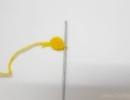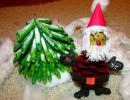Knitted scarf fox pattern. Knitted children's scarf in the shape of a fox. How to hide the ends of threads and knit a neat edge
I think that not a single mother or grandmother will argue with the statement that her child’s main activity is play. Children play always and everywhere. And not only with toys. Kids have great fun playing with food or their own clothes.
So why don’t you and I please our precious child with a new thing that will be not only a warm, cozy children’s accessory, but also a fun toy?!
I really wanted to knit an unusual scarf for my four-year-old daughter. And when I saw the work of designers Satu Dolk and Ossi Laine on Ravelry - knitted children's scarf in the form of a Fox, then without hesitation I decided to bring this wonderful idea to life.
The scarf is very easy to make. So even beginners can knit it. And the originality of this product is added by the way the scarf is tied, or more precisely, tightened around the neck. The fox's muzzle is double and is made in the form of a loop through which a lush fox tail stretches. So the knitted Fox scarf comfortably clasps the child’s neck exactly as much as required.
How to knit a children's scarf “Fox” with knitting needles
To knit a Fox scarf you will need:
- wool blend yarn – I have Alize LANAGOLD Classic (49% wool, 51% acrylic – 100 g, 240 m) pink color– 20 g and camel hair color – 50 g;
- knitting needles 3.5;
- hook;
- a pair of plastic eyes and a spout for toys.
"Tail"
1. I start knitting a children's scarf with the “tail” of the Fox. I cast on 3 stitches with pink yarn. I knit in garter stitch.
As when knitting a bactus scarf with an openwork border, the main fabric of the “Fox” scarf is knitted without edge loops, i.e. All loops, including the 2 outermost ones, are knitted the same way, with the exception of the section of the scarf knitted with an elastic band.
2. Starting from the second row of knitting, I add 2 loops in each even row. I make additions by knitting 1 loop from the broach after the outer loop at the beginning of the row and before the outer loop at the end of the row.
I increase until the number of stitches on the needles increases to 33. The length of this knitted section is 7 cm.
3. I change the color of the thread and switch to knitting with camel hair color yarn. I knit 32 rows in garter stitch. The length of this section of the scarf is also 7 cm.
The section knitted with an elastic band automatically turns out to be narrower than the main fabric of the scarf. And it is in this place that the finished scarf will be intercepted by a loop.
"torso"
5. I return again to “ garter stitch" I knit 148 rows.
In the author’s version of the “Fox” scarf, it is proposed to knit 100 rows for a children’s scarf and 140 rows if the scarf is intended for an adult. So, if desired, the number of knitting rows in this section can be increased or decreased depending on the knitting density and the thickness of the yarn.
This part of my scarf is 35 cm long.
"Head"
6. Change the color of the thread to pink. I continue knitting in garter stitch, simultaneously decreasing 2 stitches in each even row by knitting 2 stitches together after the outer loop at the beginning of the row and knitting 2 stitches together before the outer loop at the end of the row until there are 5 loops left on the needles. This is 30 rows and 8cm long.
7. I knit 2 more rows in garter stitch, after which I start adding stitches again. As when knitting the tip of the tail, I add 1 loop, knitted from a broach, at the beginning and at the end of each even row after and before the outer loops.
I knit 28 rows this way. In this case, there are again 33 loops on the knitting needles.
8. I close the loops.
"Ears"
9. I knit the Fox’s ears separately. To do this, from the loops of the first row of the head, I cast on 14 loops with pink yarn in place of the right ear.
10. I knit in garter stitch. In every second row I decrease the loops - 1 loop at the beginning and at the end of the row after and before the outer loops - in the same way as when knitting the head.
11. When there are 2 loops left on the knitting needles, I pull the working thread through them and tighten it. I hide the remaining end of the thread.
12. I cast on loops in the same way and knit the left eye.


According to original version scarf “Fox”, you can knit each ear with a separate piece, and then tie it to the head with a hook or carefully sew it on.
13. To make a loop into which the fox’s tail will be pulled, I bend the head part in half in the place with the fewest loops and sew the edge of the scarf with a crochet hook from the wrong side along the transition line between the Fox’s body and head.

14. I attach ready-made plastic toy eyes and nose. And the cheerful children's scarf “Fox” is ready!

Knit original accessories for your children with HobbyMama!
We will need:
padding polyester for stuffing some parts.
2 skeins of orange yarn;
remnants of white and black yarn;
2 black buttons on the leg;
set of knitting needles for circular knitting (5 pcs.);
2 pins;
Knitting method: garter stitch.
First let's tie the ears. Take the orange thread and cast on 16 loops. We knit with knit stitches, turn the knitting needles over and knit again, but this time with purl stitches, decreasing each row (knitting two loops together). So we repeat 6 rows. Insert black thread to create black ends. And we continue to knit, reducing the number of loops.
Using this principle, the inner part of the ear is also knitted with white thread. And there should be two such details.
Blanks for brush feet. We cast on 8 loops with black thread and knit with garter stitch, increasing to 15 loops on the knitting needle. Then we knit 3 rows and begin to reduce the number of loops to 8 on the knitting needle. We knit four such details.
Torso. We will knit the tail and body of the paw together to make a solid scarf and have no seams. Cast on 28 stitches (more or less, depending on the desired width of the scarf) and distribute them onto 4 needles. Knit 20 rows, increasing each row by 2 stitches.

Until there are 17 loops on each needle. Knit 4 more rows. Slip 8 stitches onto a pin from two adjacent knitting needles so that you can then knit the legs. Knit 223 rows in the round. Next, again remove 8 loops on the pin symmetrically first. Knit another 20 rows with knit stitches.
Now we knit the transition of the body to the tail. To do this, reduce each row by two loops until there are 12 left on each knitting needle. We knit 20 rows, and again increase the row to 17 loops on the knitting needle. Knit 63 rows in the round.
We return to our loops left on the pins. We add 10 more loops (to the already knitted 8) and knit 11 rows with orange thread. Then we change to a black thread and knit 49 rows and bind off each loop. Since the fox has four legs, we do the same thing four times.

Muzzle. We cast on 16 loops with orange thread and distribute them onto 3 knitting needles. Knit one row and divide into 3 parts (4 loops; 6 loops; 6 loops). Knit 10 rows increasing by 2 stitches per row.
Simply knit four rows with only knit stitches, distributing the stitches onto 4 knitting needles. In the next row, insert a white thread into half of the loops (the middle of this part should be at the level where we initially had 4 loops). As a result, we form an orange and white part; on 2 adjacent knitting needles we should get two different parts, orange and white. Having knitted 10 rows on each pair of knitting needles, we begin to decrease until there are 2 loops left. We pull them together with thread and secure them. The orange and white parts need to be sewn together.

We sew the blank for the muzzle from the wrong side, turn it inside out and stuff it with fiberglass.

Finishing and finishing touches. Sew the ear parts together, connecting the white and orange parts. Sew them to the top of the head. Embroider a nose on the muzzle with black thread and sew on buttons and eyes. Fold the paws in half and sew. Turn right side out and sew the body to the legs. Divide the paws and hands with black thread to form claws.

Sew the head to the body. The cheerful scarf “Fox” is ready!
You will need: Ideal yarn: 2 skeins art. 241.091 (orange), 1 hatch for all sizes art. 203.071 (burgundy), art. 207.541 (olive), art. 290.531 (khaki); knitting needles No. 3.5.
Patterns: Stockinette stitch, needles No. 3.5: see description at the end of the magazine. Jacquard, knitting needles No. 3.5: knit according to the pattern. Take 1 skein of each color, cross the threads tightly at each color change, embroider small details with a “loop” pattern. Basics of machine knitting and embroidery: see description at the end of the magazine.
Knitting density. Persons smooth 24 p. and 31 r. = 10 x 10 cm.
Work progress
The finished scarf is 93 cm long and 8 cm wide. The scarf starts with two separate parts. For the first part, cast on 4 stitches with khaki thread. Knit jacquard according to pattern A, adding on both sides every 2nd r. 1 x 1 p., 1 x 3 p., 1 x 2 p. and set aside the received 16 p. For the 2nd part, cast on 4 p. with orange thread. Knit faces. stitch, adding on both sides every 2nd r. 1 x 1 p., 1 x 3 p., 1 x 2 p. and set aside the received 16 p. Connect the loops of both parts on one knitting needle, then cast on 3 new p. with orange thread, continue knitting jacquard according to pattern A on the next 16 p. ., then cast on 4 new stitches with orange thread, knit. stitch with orange thread on the next 16 nv then cast on 3 new stitches with orange thread. On the received 42 stitches, continue knitting 23 stitches. satin stitch with orange thread, 16 stitches, jacquard A, 3 stitches. satin stitch with orange thread. After the 26th r. jacquard pattern A, continue persons. stitch with orange thread on all stitches. After 72 cm (- 224 r.) from the cast-on edge, knit jacquard according to pattern B. In the 1st r. knit 7 sts with orange thread, 7 sts with khaki thread, 14 sts with orange thread, 7 sts with khaki thread, 7 sts with orange thread. Approximately 89 cm (- 276 r.) from the cast-on edge, knit 1 knit. p., 3 p. together persons. with a slant to the right, 14 persons. p., 2 p. together persons. with a tilt to the left, 2 persons. p., 2 p. together persons. with a slant to the right, 14 persons. p.. 3 p. together persons. with a tilt to the left, 1 person. p. (= 53rd r. of the scheme). Knit 1 p. purl sts on the remaining 36 sts. In the next row, knit 1 stitch. p., 2 p. together persons. with a slant to the right, 12 faces. p., 2 p. together persons. with a tilt to the left, 2 persons. p., 2 p. together persons. with a slant to the right, 12 persons. pch 2 p. together persons. with a tilt to the left, 1 person. a Repeat these decreases 3 more times in every 2nd r. Knit 1 p. purl sts on the remaining 20 sts. In the next row, knit 1 stitch. p., 3 p. together persons. with a tilt to the right, 2 persons. p., 3 p. together persons. with a tilt to the left, 2 persons. p., 3 p. together persons. with a slant to the right. 2 persons p., 3 p. together persons. with a tilt to the left, 1 person. p. Knit 1 p. purl satin stitch on the remaining 12 stitches, then pull the thread through all the loops, tighten and secure the thread.
Ears (2 parts): cast on 12 stitches with burgundy thread. Knit 2 p. persons satin stitch 8 next row knit 1. p., add 1 p., knit 10. p., add 1 p., knit 1 stitch. p. Knit 1 p. on the received 14 sts. In the next row, knit 1. p., add 1 nv knit 3 persons. p., 2 p. together persons. with a tilt to the left, 2 persons. p., 2 p. together persons. with a tilt to the right, 3 persons. p., add 1 p., knit 1 stitch. p. Knit 3 p. on 14 p. In the next row, knit 4. p., 2 p. together persons. with a tilt to the left, 2 persons. p„ 2 p. together persons. with a tilt to the right, 4 persons. p. Knit 1 p. on the remaining 12 sts. In the next row, knit 1. p„ 3 p. together persons. with a tilt to the right, 2 persons. p., 3 p. together persons. with a tilt to the right, 1 person. p. Knit 1 p. purl p. on the remaining 6 sts and bind off all loops.
Assembly: use a loop stitch to embroider the left eyelet according to pattern C, the right eyelet according to pattern D, fold both ears in half and sew a side seam. Sew on the ears around the 26th r. diagram B. To keep one eye raised, secure it with several stitches. Fold the scarf in half and sew a side seam.
knitted scarves "Foxes for sisters"


This is the yarn I used.


The scarf consists of 3 parts: the fox's head, body and tail. And as a finishing (for authenticity) – paws.
I started knitting with the head of a fox.
Upper head: for gray fox – in 2 strands of gray “diamond”,
for a red fox – in 2 strands of red “diamond”,
knitting needles No. 3.5.
Cast on 6 loops.
1st row: purl loops.
2nd row: 2 knit, 1 increase - knit from broach, 2 knit, 1 increase - knit from broach, 2 knit.
Row 3 and all odd rows are purl stitches.
4th row and all even rows with increases.
Continue knitting until 28 loops are formed on the knitting needles.
Knit 7 rows (purl, knit, purl, knit, purl, knit, purl) without increasing.
Now you need to make decreases, knitting 2 loops after the edge loop together with a tilt to the left, and before the last loop 2 loops together with a tilt to the right.
There will be 20 loops left on the knitting needle; they need to be removed using a pin or auxiliary knitting needle.
Lower part of the muzzle: for gray fox - in 2 strands of white “diamond”, in 2 strands
gray;
for a red fox - in 2 strands of white “diamond”, in 2 strands
redhead.
From broaches initial row On the top of the chanterelle's head (from the first 6 loops), cast on 5 loops with a light thread, knit in a stocking pattern. In each front row, add 2 loops on both sides - one after the edge loop and one before the last loop.
Increase to 25 loops, in the purl row replace the white thread with a gray (red) thread and knit 5 rows without increasing (purl, knit, purl, knit, purl) and start decreasing to 19 loops. Close the loops.


Without cutting the thread, I crochet the head in a circle and turn it inside out, then cut off the thread, leaving a tip 40-50 cm long, so that I can then use this thread to sew the lower part of the muzzle to the scarf. But I’m not sewing up my neck yet.


Torso. Place 20 gray (red) loops on a needle No. 3.5 and continue with garter knitting in 3 threads - 1 gray (red) diamond thread, 2 white (red) grass threads.
In the second and fourth rows, add two loops on both sides of the knitting and continue on 24 loops to the desired length. Mine is 60 cm.
Ponytail. After the body of the required length is knitted, proceed to knitting the tail. Next, knit a 1x1 rib pattern in 3 threads, add 2 loops in the second row (1 loop on both sides). Knit a tail 40 cm long, gradually replacing the threads. For the gray fox, after 8 cm I replaced the gray diamond with light gray wool mixture (remnants from knitted hat with a shoulder), after another 8 cm the light gray half-wool was replaced with a white “diamond”, and then after 5 cm the white “diamond” was replaced with white grass and finished knitting with white grass in 3 threads. After 30 cm, I began to decrease 1 loop on the tail on both sides. I knitted the remaining 7 loops on the knitting needles with one loop and closed the knitting.
For the red fox, I gradually replaced the threads on the tail (initially 2 red “grass” and 1 red “diamond”) - first I replaced one thread of the red “grass” with a white “grass”, then the red “diamond” was replaced with a white “grass”. I finished knitting with three threads of “grass”, gradually reducing it to 5 loops.
Head finishing. I embroidered spots on the forehead of a gray fox with white grass. I stuffed the muzzle with padding polyester and hemmed the neck with the leftover thread.


Ears: cast on 16 loops with gray thread; 1st row – purl; 2nd row - front row, immediately start making decreases - 7 and 8 loops together with a tilt to the left, 9 and 10 loops together with a tilt to the right. Knit until there are 4 loops left on the needle. Knit a purl row, and in the next knit one, start adding 2 stitches per row until 16 stitches are formed on the knitting needles again. Fold the ears in half and sew them with the same thread, leaving the tip long enough so that you can sew the ears to the fox’s head.
For the gray fox, I tied the ears with white “grass”.

Front paws.
For the red fox: cast on 6 loops with black diamond yarn, knit 10 rows with garter stitch, continue with the red diamond, adding 2 loops in the 12th row. Knit another 13 rows. There are 23 rows in total. Close the loops and leave the thread long enough to sew the paws to the scarf.
For gray fox: cast on 6 loops with gray diamond thread, knit 10 rows with garter stitch, add 1 thread of white grass and knit another 14 rows. There are 24 rows in total.
Hind legs.
For the red fox: cast on 6 loops (in 2 threads) with black thread, knit 10 rows with garter stitch and continue with red “diamond” thread for another 18 rows. There are 28 loops in total. Close, leaving a thread for sewing.
For gray fox: cast on 6 loops with gray diamond thread (in 2 threads) and knit 10 loops with garter stitch, add 1 thread of white “grass” and knit another 19 rows. There are 29 rows in total. Close, leaving a thread for sewing.
Hi all! I got wrapped up and almost forgot to show off my scarf, knitted to go with the “Cute Fox” hat.

The scarf has a double muzzle of a fox - the tail is threaded through the ring and fastened with a button - the nose
Here it is unzipped

Closer muzzle

We start knitting from the tail - with white thread
4 ch, in the first loop of the chain we knit 2 dc.
2 r. 7 dc, increase like this - 2dc in the first loop, then 3dc in the next loop. loop, 2 dc in last loop
3 r. 11 dc - we make increases along the edges on both sides, in each of the first two loops we knit 2 dc, at the end we knit 2 dc in the last two loops
4 rub. 15 dc - increase in the same way as in the previous row
5 rub. 19 SSN
6 rub. 23 SSN
7 rub. 25 SSN
8 rub. 25 SSN
9 rub. 27 SSN
10 rub. 27 SSN
11 rub. 27 SSN

Throw an orange thread over your finger and knit a stitch to the end

Now I wanted to kind of incorporate orange into the white part (I don’t know what else to call it). In short, I knit the first double crochet at the top of the double crochet not on the last row, but on the row before it

Then a double crochet is tied into the middle of the double crochet of the previous row and finally I knit further as usual, but 2 more times on each side I make double crochets at the top of the double crochet not of the last row, but of the row in front of it




Next, we crochet an elastic band - alternating convex and concave double crochets. We knit this way 11 cm - the width of my scarf. Then we knit again with double crochets to the desired length of the scarf (don’t forget that there will also be a muzzle).
We knit the muzzle as follows. First, I decreased 2 loops on each side in one row, in the next 1 loop on each side, then knitted a row with convex double crochets (this is how I made the “neck”). In the next row, add 3 loops on each side.
Next, we attach a white thread - knit 5 dc in white, 17 dc in orange, 5 dc in white. In the next rows on each side we will decrease one loop - we knit like this - in white - 1 Dc, decrease - 1 Dc from two loops, 3 Dcs, then in orange 15 Dcs, then in white - 3 Dcs, decrease, 1 Dc. Thus, despite the decrease in the number of columns white remains unchanged, but the number of orange bars decreases. We knit this way until 13 loops remain. Then we knit as follows - in white - 1 dc, decrease - 1 dc from two loops, 3 dc, then from 3 orange loops we knit a common stitch in white, then 3 dc, decrease, 1 dc.
Next we knit only in white - we decrease by 1 loop on both sides. In the next row we knit like this - 1 dc, 2 dc together, 3 dc together, 2 dc together, 1 dc. Then 1 dc, 2 dc2h (dc) together through one loop, 1 dc.
Then we start knitting reverse side muzzles (white). We make increases symmetrical to the decreases in the upper part. Then we fold the muzzle in half and sew a little along the edges at the top - about 1 cm.
We knit ears - each of 2 triangles - orange and white. I have 8 loops at the base of the triangle, then another row of 8 loops, then in each row I decrease by 1 loop on each side. Then I tie both parts together with single crochets in orange. The eyes are buttons and the nose too.
All! Easy loops for everyone.






